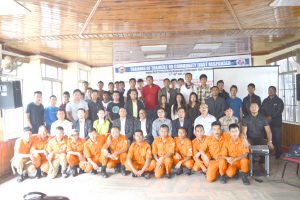Nagaland
Community First Responder trainers for Kohima begin training

Dimapur, June 27 (EMN): The District Disaster Management Authority (DDMA) of Kohima is organising a training programme for trainers of Community First Responder for Kohima district. The event has been scheduled to be conducted from June 27 and till the 30th at the Indian Red Cross Society conference hall in Kohima town.
Delivering the keynote address, Thejangulie Zao, DDMO of Kohima said that the main objective of the Community First Responders training was to impart and equip the community with the knowledge and skills required for disaster management. That way, they would be empowered to help the community during times of emergencies. He welcomed the participants, who were from different sub divisions of Kohima district.
TL Kiusumong Tikhir, additional deputy commissioner for Kohima, also addressed the gathering. He exhorted them saying that most of the time ‘we do not take the subject of disaster management seriously.’
The official urged the various stake holders of the state and village councils to be more affirmative in their response when various trainings are called and conducted.
Also, Tikhir said that disaster management was an issue that was ‘more than money.’ He cited incidences when people often came to the office only to enquire about funds for disaster management. The matter of disaster management is all about saving lives and service to the people, he reminded. The official expressed regret that people take trainings casually and give no due importance to such trainings. This is discouraging, he said. ‘It will not help us in the long run.’
Further, the additional deputy commissioner said that Kohima town being the capital of Nagaland, should be an example to the rest of the districts. The people have to be more prepared than others especially in disaster management as emergencies are bound to strike at any time and any anywhere.
‘In any disaster situations, the community is the first to respond and the community plays a very important role in disaster management because the community knows the topography, people and resources much more than any other people,’ Kiusumong Tikhir said. He urged the participants to be focussed and be open-minded saying ‘human minds are so much like an umbrella that unless it is opened, it does not work or serve its purpose.’
He concluded with a remark that disaster management was a very serious subject and that the Community First Responders will be shouldering with the responsibility to train others as they go back to their respective sub-divisions/villages.
The first day of the training will dwell on topics such as introduction to disaster management in India and Nagaland; Incident Response Systems; roles and characteristics of the Community First Responder; knotting techniques, among others.
The training was attended by members from all the five sub-divisions of Kohima district. 40 trainees are participating in the programme with more expected to join from the second day.
Training of Community First Responders in Wokha concludes
The five-day training programme for village Community First Responders organized by the Wokha District Disaster Management authorities concluded on June 23.
Seven trainers of trainers and two SDRF personnel covered six villages in Wokha sadar. They are Yikhum village, Englan village, Old Riphyim (venue), New Riphyim, old Chungsu village and new Chungsu village. Ten Community First Responders from each village and 60 Community First Responders completed the village-level training.
Further, six trainers of trainers and two SDRF personnel covered five villages in Bhandari sub-division. They are Bhandari town (venue), Bhandari village, Merapani, Yimparasa village and Lio-Longchum. Ten Community First Responders from each village and 50 Community First Responders volunteers completed the village-level training.
Four trainers of trainers and two SDRF personnel covered five villages in Ralan sub-division. They are Yanpha (venue), old Ralan, Ronsuyan, Chandlashung B, and new Chandlashung. Ten Community First Responders from each village and 50 Community First Responders completed the village-level training programme.
Three trainers of trainers and three SDRF personnel covered five villages in Sanis sub-division. They are Sanis village (venue), Tsopo village, Chudi village, Sunglup village and Yonchochu.
Ten CFR volunteers from each village and 50 CFR volunteers completed the village level training.
210 Community First Responders from four sub-divisions were trained during the programme.
Community First Responder
A Community First Responder is a person available to be dispatched to attend emergencies in their local area. They can be members of the public, who have received basic training in life saving interventions such as defibrillation, off duty ambulance staff, or professionals from a non-medical discipline who may be nearby or attending emergencies, such as fire-fighters or security officers. Community first responders are found in the emergency healthcare systems of the United Kingdom, the United States, Israel and Australia.
Community First Responders are there to provide assistance to those with a medical emergency, and most importantly to start and maintain the chain of survival in cardiac arrest patients until a fully equipped ambulance arrives.
The schemes were originally envisaged for rural areas where emergency medical services response is likely to be delayed beyond the approximate 8–10 minutes during which a cardiac arrest is likely to become irreversible. The schemes have since expanded to more populous areas, where the benefit of early intervention can still prove life saving, and the volume of people available to ambulance control assists them with meeting response time targets such as ORCON.
Examples of first responders include “co-responders” (police or fire service), members of staff of a shopping mall or other public place, members of a first aid organisation, lifeguards, community first responders, and others who have been trained to act in this capacity.
Employees of the statutory ambulance services may also act as first responders whilst off-duty.
(Inputs on Community First Responders: Wikipedia)

